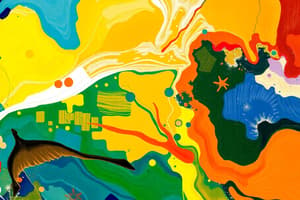Podcast
Questions and Answers
What are the three main layers of the Earth's structure?
What are the three main layers of the Earth's structure?
The crust, the mantle, and the core
What is plate tectonics?
What is plate tectonics?
The study of the movement of the Earth's crust, which is divided into large pieces called tectonic plates
What is the Earth's atmosphere composed of?
What is the Earth's atmosphere composed of?
A mixture of gases
What causes earthquakes and volcanic eruptions?
What causes earthquakes and volcanic eruptions?
In what region is the movement of the Pacific Plate most famous for causing earthquakes and volcanic activity?
In what region is the movement of the Pacific Plate most famous for causing earthquakes and volcanic activity?
What is the highest layer of the Earth's atmosphere?
What is the highest layer of the Earth's atmosphere?
Where is freshwater found on Earth?
Where is freshwater found on Earth?
What is climate?
What is climate?
What are natural resources?
What are natural resources?
What does the Earth's space environment include?
What does the Earth's space environment include?
Flashcards are hidden until you start studying
Study Notes
General Science and Earth Science
General science is the study of the natural world and the various branches of science that seek to explain and understand the phenomena that occur within it. Earth science is a specific subfield of general science that focuses on the study of the Earth, its physical and chemical properties, and the processes that shape it. In this article, we will explore some of the key concepts and subtopics within earth science.
Earth's Structure
The Earth's structure is divided into three main layers: the crust, the mantle, and the core. The crust is the outermost layer, which is relatively thin, solid, and cool. The mantle is the thick layer beneath the crust, which is hot and semi-fluid. The core is the center of the Earth, which is very hot and solid.
Plate Tectonics
Plate tectonics is the study of the movement of the Earth's crust, which is divided into large pieces called tectonic plates. These plates move slowly over time, causing earthquakes and volcanic eruptions. The most famous example of plate tectonics is the movement of the Pacific Plate, which causes earthquakes and volcanic activity in the Pacific Ring of Fire.
Earth's Atmosphere
The Earth's atmosphere is a mixture of gases that surrounds the planet. It is divided into five layers: the troposphere, the stratosphere, the mesosphere, the thermosphere, and the exosphere. The troposphere is the lowest layer, where all weather occurs. The stratosphere is the second layer, where the ozone layer is located. The mesosphere is the third layer, where meteors burn up. The thermosphere is the fourth layer, where the aurora occurs. The exosphere is the highest layer, where the gases are so thin that they can escape into space.
Earth's Water
Water is a vital resource on Earth, and it is essential for all forms of life. Earth's water is divided into two main categories: freshwater and saltwater. Freshwater is found in lakes, rivers, and underground aquifers. Saltwater is found in the oceans and seas. The water cycle is the process by which water is constantly recycled from the Earth's surface to the atmosphere and back again.
Earth's Climate
Climate is the long-term weather pattern of a region, and it is influenced by a variety of factors, including temperature, precipitation, winds, and ocean currents. Climate change is a significant issue facing the Earth today, with many scientists predicting that global temperatures will continue to rise in the coming decades.
Earth's Natural Resources
Natural resources are the raw materials that the Earth provides for human use. They include minerals, fossil fuels, and water. Natural resources are essential for human survival, but their extraction and use can have negative impacts on the environment.
Earth's Environment
The Earth's environment is the sum of all the physical and biological conditions that make it possible for life to exist. It includes the air we breathe, the water we drink, and the soil we walk on. Human activities, such as pollution and deforestation, can have a significant impact on the Earth's environment.
Earth's Space Environment
The Earth's space environment refers to the conditions that exist in space around the Earth. It includes the magnetic field, the solar wind, and the space debris. The Earth's magnetic field protects the planet from charged particles from the sun, while the solar wind is a stream of charged particles that flows from the sun. Space debris is the accumulation of objects that have been launched into space, which can pose a risk to satellites and spacecraft.
In conclusion, earth science is a fascinating and complex field that seeks to understand the Earth and its many processes. From the structure of the Earth to its climate and natural resources, earth science helps us to appreciate the beauty and complexity of our world. By studying and understanding these concepts, we can better protect and conserve the Earth for future generations.
Studying That Suits You
Use AI to generate personalized quizzes and flashcards to suit your learning preferences.




